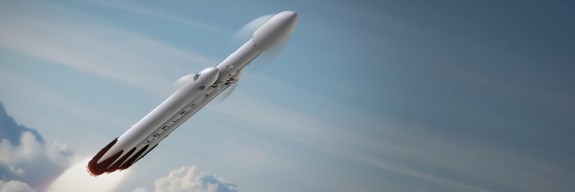If everything goes well, this mission will be launched late 2018. Musk didn't identify the passengers but stated the two individuals already paid a significant deposit to do a free-return trajectory around the Moon. Musk reportedly said the trip costs about the same as what it would take for a private citizen to visit the International Space Station (ISS). The last space tourist was Guy Laliberte, one of the co-founders of Cirque du Soleil. He spend 11 days in space in 2009 and is believed to have paid $40 million for this trip. We also know Russia currently charges NASA around $80 million per seat for launches to the ISS.
The approximately week-long mission will use the SpaceX Falcon Heavy rocket and the Dragon 2 capsule. Falcon Heavy is expected to make its maiden flight in Q2 2017 while the first uncrewed test flight of Dragon 2 is scheduled for November 2017. According to Musk, the Dragon 2 has about the same internal volume as an average SUV. It's not very spacious but it should be enough for this short trip for these two lucky but very adventurous citizens.
Moreover, the statement hints that more flight teams are expected to follow as SpaceX received inquiries from multiple parties. Here's the full announcement from SpaceX:
We are excited to announce that SpaceX has been approached to fly two private citizens on a trip around the moon late next year. They have already paid a significant deposit to do a moon mission. Like the Apollo astronauts before them, these individuals will travel into space carrying the hopes and dreams of all humankind, driven by the universal human spirit of exploration. We expect to conduct health and fitness tests, as well as begin initial training later this year. Other flight teams have also expressed strong interest and we expect more to follow. Additional information will be released about the flight teams, contingent upon their approval and confirmation of the health and fitness test results.If the mission doesn't suffer delays, it would come roughly in time for the celebration of the 50th anniversary of the Apollo 8 mission. Launched on December 21, 1968, this was the first crewed spacecraft to leave Earth orbit. The last manned Moon mission launched on December 7, 1972.
Most importantly, we would like to thank NASA, without whom this would not be possible. NASA’s Commercial Crew Program, which provided most of the funding for Dragon 2 development, is a key enabler for this mission. In addition, this will make use of the Falcon Heavy rocket, which was developed with internal SpaceX funding. Falcon Heavy is due to launch its first test flight this summer and, once successful, will be the most powerful vehicle to reach orbit after the Saturn V moon rocket. At 5 million pounds of liftoff thrust, Falcon Heavy is two-thirds the thrust of Saturn V and more than double the thrust of the next largest launch vehicle currently flying.
Later this year, as part of NASA’s Commercial Crew Program, we will launch our Crew Dragon (Dragon Version 2) spacecraft to the International Space Station. This first demonstration mission will be in automatic mode, without people on board. A subsequent mission with crew is expected to fly in the second quarter of 2018. SpaceX is currently contracted to perform an average of four Dragon 2 missions to the ISS per year, three carrying cargo and one carrying crew. By also flying privately crewed missions, which NASA has encouraged, long-term costs to the government decline and more flight reliability history is gained, benefiting both government and private missions.
Once operational Crew Dragon missions are underway for NASA, SpaceX will launch the private mission on a journey to circumnavigate the moon and return to Earth. Lift-off will be from Kennedy Space Center’s historic Pad 39A near Cape Canaveral – the same launch pad used by the Apollo program for its lunar missions. This presents an opportunity for humans to return to deep space for the first time in 45 years and they will travel faster and further into the Solar System than any before them.
Designed from the beginning to carry humans, the Dragon spacecraft already has a long flight heritage. These missions will build upon that heritage, extending it to deep space mission operations, an important milestone as we work towards our ultimate goal of transporting humans to Mars.
